Both Berlin and Hamburg are amazing cities to visit, each with its own unique charms. However, choosing between the two can be difficult.
In this article, I will provide a comprehensive comparison of Berlin and Hamburg, covering various aspects such as city profile, history, cost, transport, climate, safety, health, education, jobs, culture, cuisine, nightlife, shopping, festivals, recreation, living quality, connectivity, innovation, economy, job market, visa, top attractions, and shopping.
By the end of this article, you’ll have a better understanding of which city might be the best fit for your next European adventure.

Table of Contents
Key Takeaways:
- Berlin and Hamburg both offer unique experiences and attractions for visitors.
- Consider factors such as cost of living, transportation, and climate when comparing the two cities.
- Both cities have a rich history and cultural scene, but Berlin is known for its vibrant nightlife while Hamburg offers a more relaxed and sophisticated atmosphere.
- Explore the top attractions in each city, such as the Brandenburg Gate in Berlin and the Elbphilharmonie in Hamburg.
- The choice between Berlin and Hamburg ultimately depends on individual preferences and interests.
Berlin vs Hamburg
City Profile

When it comes to city profiles, both Berlin vs Hamburg have their own unique characteristics that make them stand out. Berlin, the capital city of Germany, is known for its rich history, vibrant cultural scene, and diverse population.
With its iconic landmarks such as the Brandenburg Gate and the Berlin Wall Memorial, the city offers a fascinating glimpse into the past. Berlin’s thriving arts and music scenes, along with its eclectic mix of modern and historic architecture, contribute to its vibrant atmosphere.
Hamburg, on the other hand, is the second-largest city in Germany and is famous for its maritime heritage and bustling port. The city boasts stunning architecture, including the mesmerizing Elbphilharmonie and the historic Speicherstadt.
Hamburg’s scenic waterfront, charming canals, and picturesque parks make it a city of natural beauty. Known for its cosmopolitan vibe and relaxed atmosphere, Hamburg offers a unique blend of modernity and tradition.
Both Berlin and Hamburg have their own distinct identities, and exploring their city profiles allows visitors to immerse themselves in the rich history and culture of each place.
History
The history of Berlin is rich and complex, shaped by its strategic location and historical events. It has served as the capital of various German states throughout the centuries.
Berlin played a significant role in both World War I and World War II, and was famously divided by the Berlin Wall during the Cold War. The scars of the past can still be seen in the city’s architecture and memorials, reminding visitors of its turbulent history.
Hamburg, on the other hand, has a history deeply intertwined with its maritime trade. As one of the most important port cities in Europe, it has been a center of commerce since the Middle Ages.
Hamburg’s history is reflected in its stunning architecture, such as the Speicherstadt warehouse district, and its vibrant maritime heritage. Exploring the city allows visitors to delve into its history and experience its unique blend of tradition and modernity.
Understanding the historical background of Berlin and Hamburg is essential to fully appreciate their cultural and architectural differences. While Berlin showcases the remnants of its tumultuous past, Hamburg embraces its maritime roots and prosperous trading history.
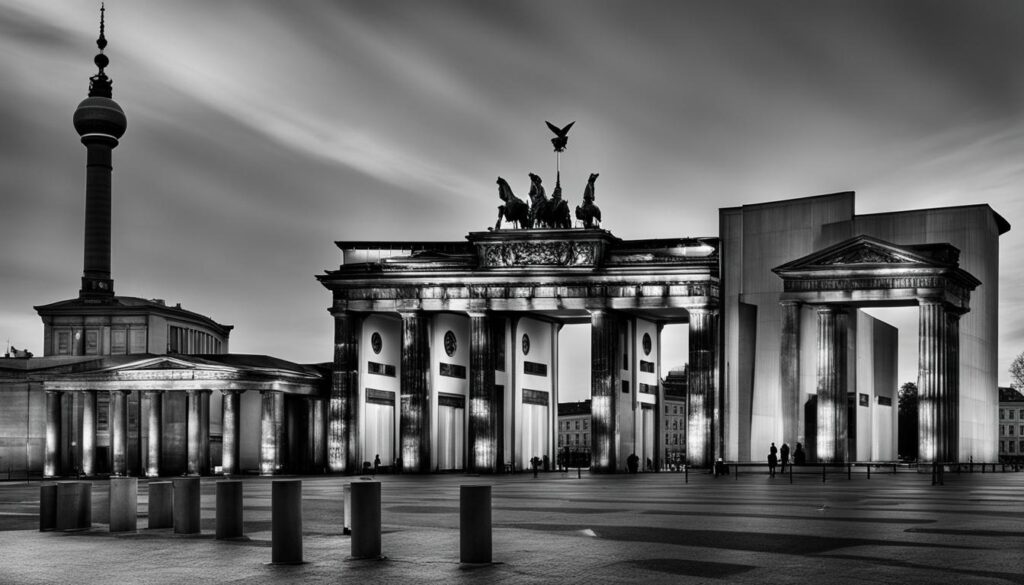
Cultural Contrasts
Berlin’s history is evident in its diverse cultural scene, which embraces both its German heritage and its status as a cosmopolitan city. From the iconic Brandenburg Gate to the vibrant street art in the East Side Gallery, Berlin offers a unique blend of historical landmarks and contemporary artistic expression.
Hamburg, on the other hand, showcases a more refined cultural experience. With its world-class opera house, Elbphilharmonie, and renowned museums, such as Kunsthalle Hamburg, the city offers a sophisticated cultural scene that reflects its status as a center of arts and music.
Exploring the cultural contrasts between Berlin and Hamburg allows visitors to appreciate the diverse artistic expressions and historical influences that have shaped these two remarkable German cities.
Architectural Heritage
The architecture of Berlin and Hamburg reflects the different historical periods and influences that have shaped these cities. Berlin boasts a mix of architectural styles, from the grandeur of the Prussian-era buildings to the modernist structures of the Bauhaus movement. The city’s diverse architectural landscape is a testament to its rich history and its identity as a melting pot of cultures.
Hamburg, on the other hand, is known for its stunning waterfront buildings and red-brick warehouses in the historic Speicherstadt district. The city’s architecture is characterized by its maritime heritage, with beautifully preserved buildings that tell the story of its trading past.
Exploring the architectural heritage of Berlin and Hamburg offers a glimpse into their respective histories and the influences that have shaped their unique cityscapes.
Cost of Living
When comparing the cost of living in Berlin and Hamburg, it is important to consider various factors such as accommodation, transportation, and everyday expenses. While Berlin is generally considered to be more affordable than other major European capitals, Hamburg also offers a reasonable cost of living. Let’s take a closer look at some of the key areas where costs may differ between the two cities.
Housing
Both Berlin and Hamburg offer a range of housing options, from apartments to houses. In Berlin, the cost of rent tends to be more affordable compared to Hamburg, especially in the city center. However, Hamburg may offer a wider variety of upscale housing options, which can drive up the overall cost of living in the city. It’s important to consider your budget and personal preferences when looking for housing in either city.
Transportation
When it comes to transportation, both Berlin and Hamburg have efficient public transit systems. Berlin’s extensive network of buses, trams, and trains provides affordable options for getting around the city.
Hamburg, on the other hand, has a well-connected metro system and ferry services. While the cost of transportation can vary depending on your usage and location, both cities offer reasonably priced public transportation options.
| Berlin | Hamburg | |
|---|---|---|
| Rent for 1-bedroom apartment (city center) | $1,000 – $1,500 | $1,200 – $1,800 |
| Monthly public transportation pass | $90 | $90 |
| Meal at an inexpensive restaurant | $10 – $15 | $12 – $18 |
Everyday Expenses
In terms of everyday expenses such as groceries, dining out, and entertainment, both Berlin and Hamburg offer a range of options to suit different budgets.
While prices may vary depending on the neighborhood and establishment, overall, Berlin tends to be more affordable than Hamburg. It’s important to note that personal spending habits and lifestyle choices can greatly influence the overall cost of living in either city.
When comparing the cost of living in Berlin and Hamburg, it is clear that both cities have their own unique advantages and considerations.
While Berlin may have a slight edge in terms of affordability, Hamburg offers a diverse range of upscale housing options and a slightly higher standard of living. Ultimately, the choice between the two cities will depend on your personal preferences, budget, and lifestyle.

Transportation
When it comes to getting around Berlin and Hamburg, both cities offer efficient and well-connected public transportation systems. In Berlin, the public transport network consists of buses, trams, and trains, making it easy to navigate the city and reach your desired destinations.
The extensive network covers all major areas, including the city center, suburbs, and even the surrounding regions.
Similarly, Hamburg also has a reliable and convenient public transport system. The city is served by a metro system known as the U-Bahn, which covers a wide range of stations throughout Hamburg. In addition to the U-Bahn, there are also bus lines and ferry services available, providing alternative transportation options for residents and visitors.
Whether you choose to explore Berlin or Hamburg, public transport can be a cost-effective and efficient way to get around. It’s recommended to purchase a travel card or ticket, which allows unlimited travel within a specified period and offers discounted rates compared to buying single tickets.
With the extensive public transport options in both cities, you can easily access popular tourist attractions, shopping districts, and cultural landmarks.
Public Transport Options in Berlin and Hamburg
Here’s a comparison of the public transport options in Berlin and Hamburg:
| Transportation in Berlin | Transportation in Hamburg | |
|---|---|---|
| Metro System | S-Bahn and U-Bahn | U-Bahn |
| Bus | Extensive bus network | Bus lines |
| Tram | Tram lines | N/A |
| Ferry | Ferry services on the Spree River | Ferry services on the Elbe River and canals |
As you can see, both cities offer a range of public transport options, allowing you to choose the most convenient mode of transportation based on your specific needs and preferences. Whether you prefer to travel by metro, bus, tram, or even ferry, Berlin and Hamburg have you covered.
Climate
When it comes to climate, both Berlin and Hamburg experience similar weather patterns. Summers in both cities are generally warm, with temperatures ranging from 20 to 30 degrees Celsius (68 to 86 degrees Fahrenheit).
However, Hamburg tends to be slightly cooler compared to Berlin, thanks to its coastal location along the North Sea. Winters in both cities can be cold, with temperatures dropping below freezing. However, Berlin tends to have colder winters with the possibility of snowfall, while Hamburg experiences milder winters with less snow.
One notable difference between the two cities is the amount of rainfall. Hamburg is known for its slightly wetter climate, with more rainfall throughout the year compared to Berlin.
This can be attributed to its proximity to the North Sea and its maritime climate. It’s always a good idea to pack an umbrella or raincoat when visiting Hamburg, as it experiences more frequent rain showers compared to Berlin.
Overall, both Berlin and Hamburg offer a pleasant climate for visitors, with distinct seasons and mild temperatures. Whether you prefer the slightly cooler temperatures of Hamburg or the possibility of snowy winters in Berlin, both cities provide a unique experience no matter the time of year.
Climate Comparison Between Berlin and Hamburg
| City | Summer Temperature | Winter Temperature | Average Rainfall |
|---|---|---|---|
| Berlin | 20-30°C (68-86°F) | Below freezing | ~570 mm/year |
| Hamburg | 18-25°C (64-77°F) | Above freezing | ~780 mm/year |
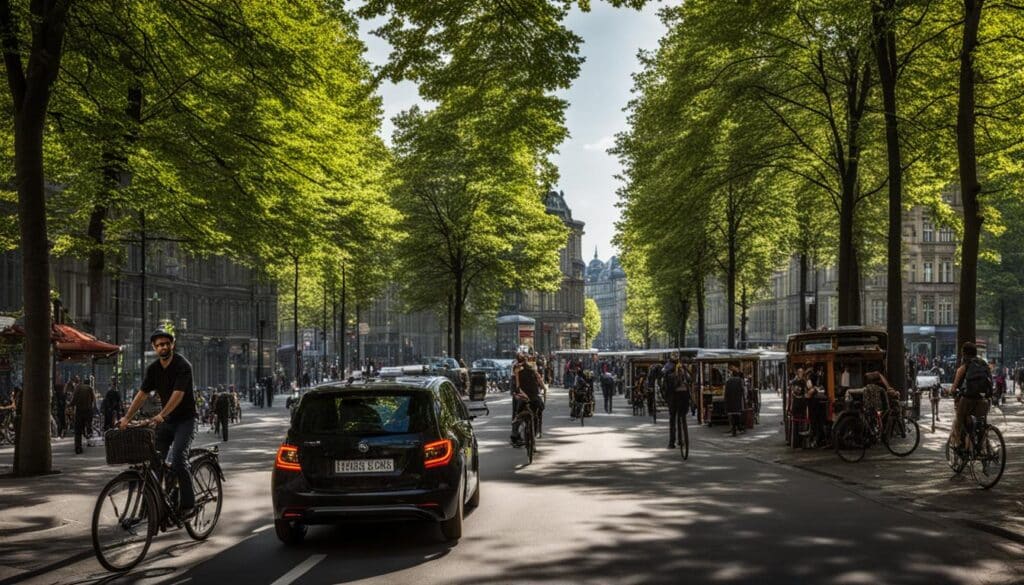
The climate in Berlin and Hamburg is similar, with warm summers and cold winters. However, Hamburg tends to be slightly wetter than Berlin, with more rainfall throughout the year. It’s important to consider the climate when planning your visit, as it can impact your experience and the activities you can participate in.
Safety in Berlin and Hamburg
When it comes to safety, both Berlin and Hamburg are considered to be relatively safe cities compared to other major European cities. While crime can occur in any city, the crime rates in Berlin and Hamburg are generally low. However, it is still important to take basic safety precautions and be aware of your surroundings, especially in crowded tourist areas.
Crime rate in Berlin:
- Property crime: Low
- Violent crime: Low
- Pickpocketing: Moderate
- Tourist targeted scams: Low
Crime rate in Hamburg:
- Property crime: Low
- Violent crime: Low
- Pickpocketing: Moderate
- Tourist targeted scams: Low
While the overall crime rates are low, it is always advisable to take some safety measures. Here are some safety tips for both cities:
- Be aware of your surroundings and keep an eye on your belongings at all times.
- Avoid displaying valuable items, such as expensive jewelry or large amounts of cash, in public.
- Use well-lit and busy streets, especially at night.
- Be cautious when using ATMs and try to use ones located in well-populated areas.
- If you’re traveling alone, let someone know your plans and always have a way to communicate in case of emergencies.
By following these safety tips and using common sense, you can have a safe and enjoyable experience in both Berlin and Hamburg.
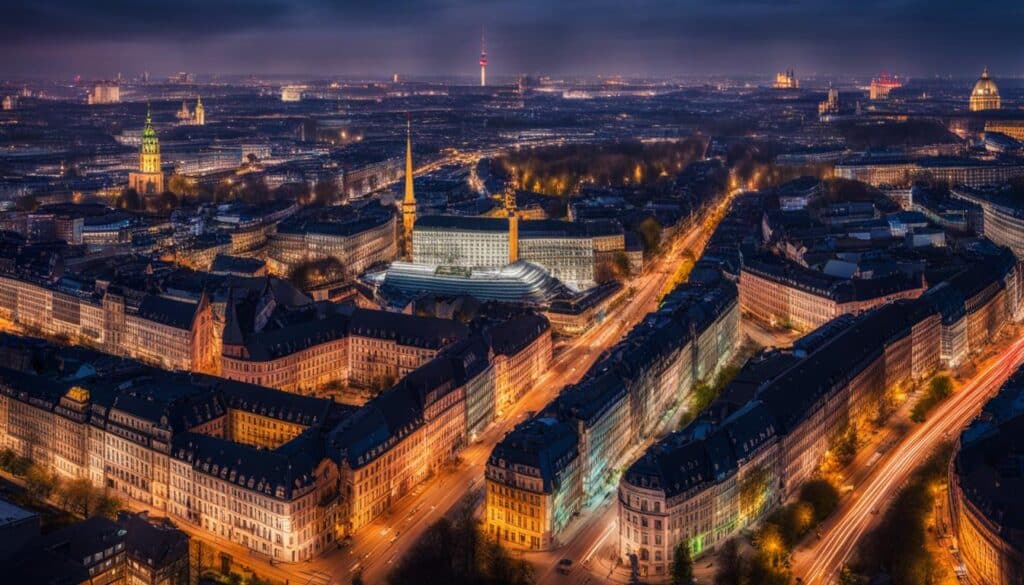
| Crime Rate | Pickpocketing | Tourist Targeted Scams | |
|---|---|---|---|
| Berlin | Low | Moderate | Low |
| Hamburg | Low | Moderate | Low |
Health and Education
When it comes to healthcare and education, both Berlin and Hamburg offer excellent options for residents and expats. In terms of healthcare, both cities have well-developed systems with a range of hospitals and clinics to cater to different medical needs.
In Berlin, some of the top hospitals include Charité – Universitätsmedizin Berlin, Vivantes Netzwerk für Gesundheit, and Helios Klinikum Berlin-Buch. These medical facilities provide quality care and have a wide range of specialties.
Similarly, Hamburg is home to renowned hospitals such as Universitätsklinikum Hamburg-Eppendorf, Asklepios Kliniken Hamburg, and Marienkrankenhaus Hamburg, ensuring access to top-notch medical services.
When it comes to education, both cities offer a variety of schools and universities. Berlin is known for its prestigious institutions such as Freie Universität Berlin, Humboldt-Universität zu Berlin, and Technische Universität Berlin, providing a wide range of academic programs.
Hamburg is also home to well-regarded universities like Universität Hamburg and HafenCity University Hamburg, known for their research and educational excellence.
Furthermore, both Berlin and Hamburg have a comprehensive school system, offering options for primary, secondary, and international education.
Berlin has a diverse range of schools, including public, private, and international institutions, while Hamburg provides a variety of public schools and private international schools to cater to different educational preferences.
Overall, whether it’s healthcare or education, both Berlin and Hamburg ensure access to quality services and institutions, making them ideal places to live and study.

Job Market and Economy
When it comes to the job market and economy, both Berlin and Hamburg offer plenty of opportunities for professionals in various industries. As the capital city of Germany, Berlin has a thriving and dynamic job market, particularly known for its booming start-up scene.
The city attracts entrepreneurs and innovators from around the world, making it an ideal place for those seeking job opportunities in the tech and creative sectors. Berlin also has a strong presence in industries such as tourism, finance, and healthcare, providing a diverse range of employment options.
Hamburg, on the other hand, is a major economic hub in Germany with a strong focus on trade and logistics. The city’s bustling port plays a crucial role in its economy, attracting companies involved in shipping, warehousing, and international trade.
Additionally, Hamburg has a well-established maritime industry, offering job opportunities in areas such as shipbuilding and maritime services. The city also has a growing presence in sectors like renewable energy, media, and aerospace, presenting favorable prospects for professionals in these fields.
To illustrate the job market and economic landscape of Berlin and Hamburg, we can compare some key indicators:
| Job Market | Economy | |
|---|---|---|
| Berlin | Thriving start-up scene Opportunities in tech, creative, tourism, finance, and healthcare sectors | Diverse economy with a focus on innovation and entrepreneurship |
| Hamburg | Strong presence in trade and logistics Opportunities in maritime, renewable energy, media, and aerospace sectors | Economic hub with a focus on international trade and shipping |
It’s important to note that the job market and economy can fluctuate over time, so it’s advisable to stay updated on current trends and developments in both Berlin and Hamburg.
Conducting thorough research and networking within your desired industry can greatly enhance your chances of finding suitable job opportunities in either city.
Culture and Cuisine
Exploring the culture and cuisine of Berlin and Hamburg is a delightful journey that unveils the unique flavors and vibrant artistic scenes of these German cities. Berlin, known for its bohemian vibe, is a melting pot of creativity and diverse cultural influences.
The city is home to numerous museums, galleries, and theaters, showcasing everything from classic art to avant-garde installations. Berlin’s cultural scene is a testament to its rich history and the resilience of its people.
Hamburg, on the other hand, exudes an elegant sophistication with its maritime heritage and grand architecture.
The city boasts world-class opera houses and renowned theaters, offering captivating performances that leave a lasting impression. Hamburg’s cultural scene is a blend of classical and contemporary, catering to a wide range of artistic tastes.
When it comes to cuisine, both Berlin and Hamburg offer tantalizing experiences for food enthusiasts. German cuisine takes center stage, with hearty dishes like bratwurst, sauerkraut, and pretzels.
Berlin’s street food scene is a must-try, with its famous currywurst and döner kebabs satisfying cravings any time of the day. In Hamburg, seafood lovers rejoice as fresh fish, especially herring, is a staple. The city is also known for its delicious Franzbrötchen, a local sweet pastry.
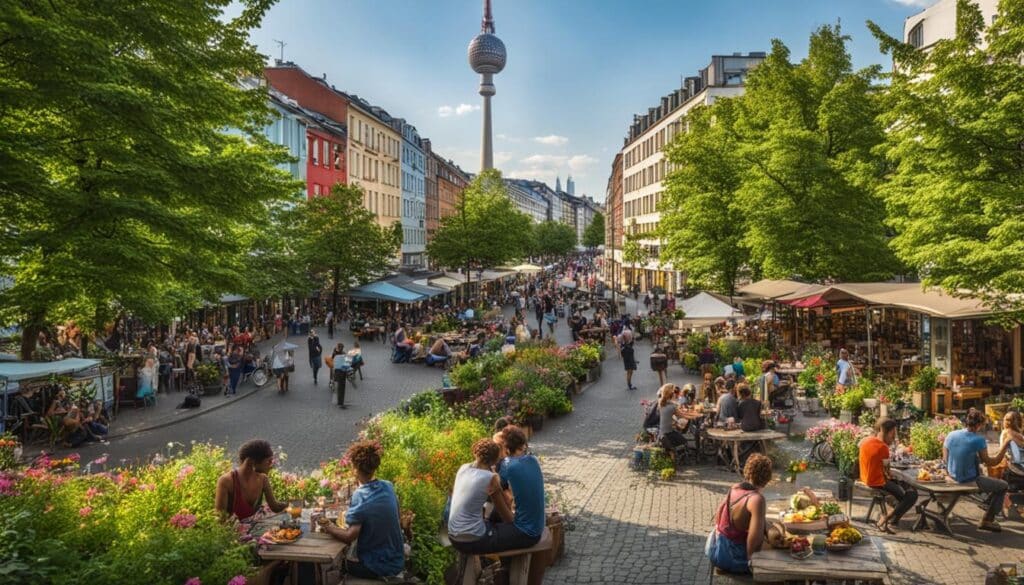
Experience the vibrant cultural scenes and mouthwatering cuisine of Berlin and Hamburg, and immerse yourself in the unique flavors and artistic expressions that make these cities truly exceptional.
Nightlife
When it comes to nightlife, both Berlin and Hamburg offer an exciting and vibrant scene that will keep you entertained well into the early hours of the morning. Whether you’re looking for trendy bars, lively clubs, or cozy pubs, both cities have something to suit every taste and preference.
In Berlin, known as the party capital of Europe, you’ll find a diverse range of nightlife options that cater to all music genres and subcultures.
The city is renowned for its underground clubs, such as Berghain and Watergate, where you can dance the night away to electronic beats. If you prefer a more relaxed atmosphere, explore the hip neighborhoods of Kreuzberg and Friedrichshain, which are dotted with quirky bars and beer gardens.
Hamburg, on the other hand, offers a more sophisticated nightlife experience. The city’s waterfront location lends itself to a unique atmosphere, with stylish bars and lounges overlooking the Elbe River.
Head to the St. Pauli neighborhood for a taste of Hamburg’s famous Reeperbahn, where you’ll find a mix of lively bars, music venues, and adult entertainment. If jazz is your thing, don’t miss the iconic Cotton Club, where you can enjoy live performances in an intimate setting.
Differences
While both Berlin and Hamburg have thriving nightlife scenes, there are some notable differences that set them apart. Berlin is known for its more eclectic and alternative vibe, with a focus on electronic music and underground clubs. In contrast, Hamburg offers a more upscale and sophisticated nightlife experience, with a variety of waterfront bars and jazz clubs. Whether you’re looking to dance until dawn or enjoy a relaxed evening with a cocktail, both cities have plenty to offer.
Regardless of whether you choose Berlin or Hamburg for your next night out, you can be sure to have a memorable experience. The cities’ diverse and vibrant nightlife scenes make them the perfect destinations for partygoers and music lovers alike. So, put on your dancing shoes and get ready to explore the dynamic and exhilarating nightlife of Berlin and Hamburg.
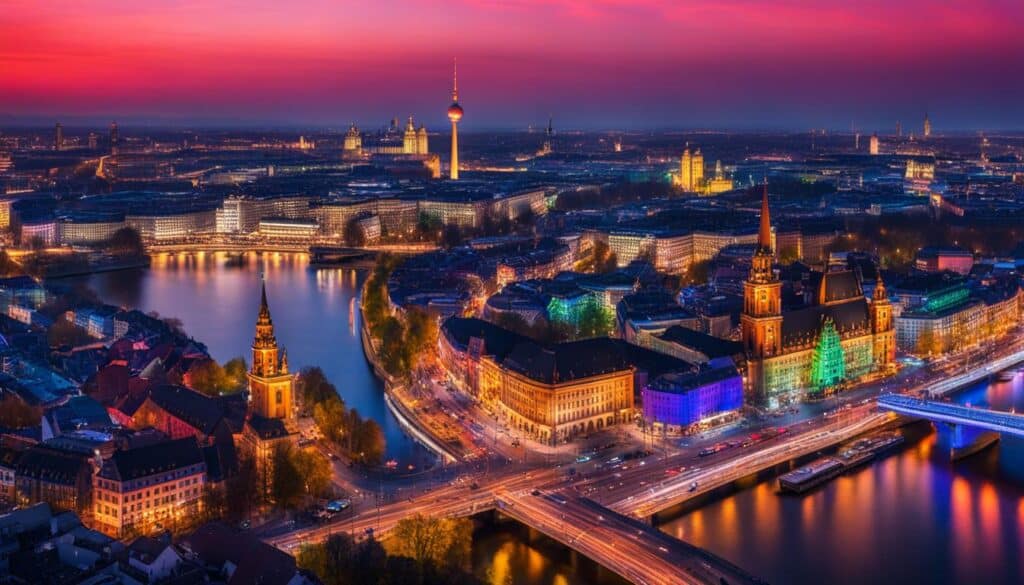
| Berlin | Hamburg | |
|---|---|---|
| Bars | Quirky bars in Kreuzberg and Friedrichshain | Stylish waterfront bars in the St. Pauli neighborhood |
| Clubs | Underground clubs like Berghain and Watergate | Lively clubs on the famous Reeperbahn |
| Music | Electronic music and a focus on underground scenes | Jazz clubs and live performances |
Shopping
When it comes to shopping, both Berlin and Hamburg offer an array of options to suit every taste and budget. Whether you’re searching for high-end designer brands or unique local boutiques, you’ll find it all in these vibrant cities.
In Berlin, some of the best shopping areas include Kurfürstendamm, also known as Ku’Damm, which is home to luxury shops and department stores. Another popular shopping destination is Friedrichstrasse, where you’ll find a mix of well-known international brands and local boutiques.
For a more alternative shopping experience, head to the districts of Kreuzberg and Prenzlauer Berg, where you’ll discover vintage stores, independent designers, and flea markets.
In Hamburg, the city’s main shopping street is Mönckebergstrasse, which offers an extensive selection of department stores, fashion chains, and specialty shops. For a more upscale shopping experience, visit Neuer Wall, an exclusive street lined with luxury boutiques and designer stores.
If you’re looking for a unique shopping experience, the Schanzenviertel neighborhood is known for its independent shops, trendy boutiques, and concept stores.
| Shopping Areas in Berlin | Shopping Areas in Hamburg |
|---|---|
| Kurfürstendamm (Ku’Damm) | Mönckebergstrasse |
| Friedrichstrasse | Neuer Wall |
| Kreuzberg and Prenzlauer Berg | Schanzenviertel |
The Best Shopping Centers in Berlin and Hamburg
Both Berlin and Hamburg are home to modern shopping centers that offer a wide range of shops, entertainment, and dining options. These shopping centers are perfect for those looking for a one-stop shopping experience.
In Berlin, one of the most popular shopping centers is Mall of Berlin, located near Potsdamer Platz. It boasts over 270 shops, including international brands, fashion boutiques, and electronics stores. Another prominent shopping center is Alexa, located on Alexanderplatz, which houses a variety of fashion, beauty, and technology stores.
In Hamburg, Alstertal Einkaufszentrum is a renowned shopping destination, offering over 240 shops spread across four floors. It features a mix of international brands, local boutiques, and specialty stores. Another notable shopping center is Europa Passage, located in the heart of the city, which offers a diverse selection of shops, cafes, and restaurants.
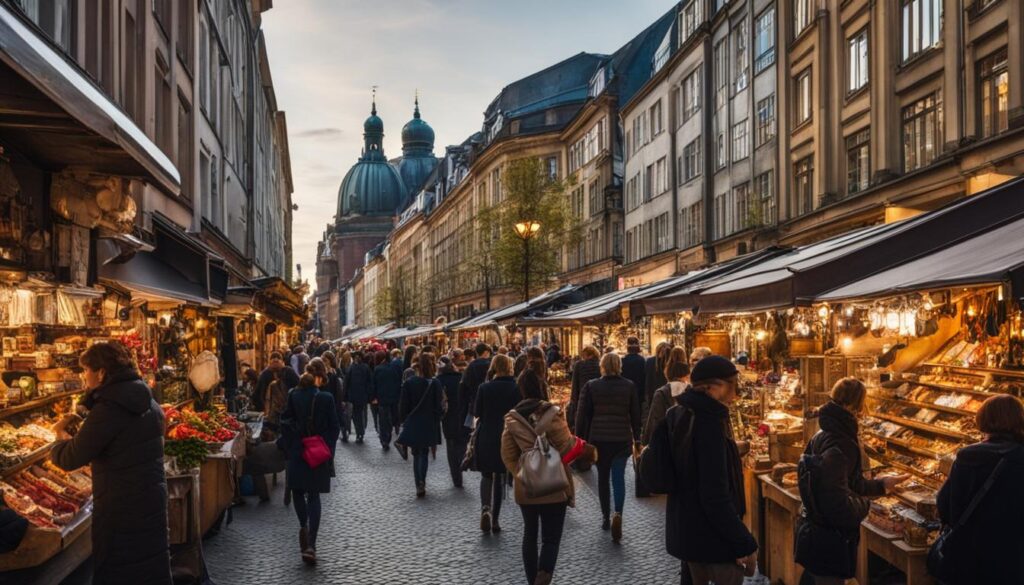
“I love exploring the vibrant shopping scenes in both Berlin and Hamburg. From high-end luxury boutiques to quirky vintage stores, there’s always something exciting to discover. Whether you’re a fashion enthusiast or a souvenir hunter, you’re sure to find unique treasures in these German cities.” – Traveler
Top Attractions
When it comes to top attractions, both Berlin and Hamburg offer a wealth of must-see places that showcase the rich history and vibrant culture of these German cities. In Berlin, visitors can explore iconic landmarks such as the Brandenburg Gate, the symbol of the city’s unity and triumph over division.
The Gate is located in the heart of the city and is a significant historical site. Another must-visit destination is the Berlin Wall Memorial, which stands as a reminder of the city’s turbulent past and the struggle for freedom. Museum Island is also a popular attraction, with its collection of world-class museums that house artifacts spanning centuries of human history.
In Hamburg, one of the top attractions is the Elbphilharmonie, a stunning architectural masterpiece that is home to a world-class concert hall. Visitors can enjoy breathtaking views of the city from its observation deck or experience a live performance in the grand auditorium.
Another must-see place is the Speicherstadt, the largest warehouse district in the world and a UNESCO World Heritage site. This historic area is known for its red-brick buildings, picturesque canals, and charming waterfront cafes. Lastly, no visit to Hamburg would be complete without a trip to the Miniatur Wunderland, the world’s largest model railway exhibition.
This fascinating attraction features meticulously crafted miniature landscapes that showcase various regions and cultures from around the world.
Historic Landmarks in Berlin and Hamburg
While the aforementioned attractions are highlights, both Berlin and Hamburg are home to many other landmarks that are worth exploring.
In Berlin, visitors can also visit the Reichstag Building, the seat of the German parliament, where they can take a guided tour and enjoy panoramic views of the city from its glass dome. The Berlin Cathedral, with its magnificent architecture and stunning interior, is another must-visit landmark that reflects the city’s cultural heritage.
Additionally, the Checkpoint Charlie Museum offers a fascinating insight into the history of the Berlin Wall and the stories of those who attempted to cross it.
In Hamburg, visitors can explore the St. Michael’s Church, one of the city’s most recognizable landmarks. The stunning baroque-style church features a towering spire and offers panoramic views of the city from its observation deck.
Another landmark worth visiting is the Hamburg Rathaus, the city’s impressive town hall that is renowned for its elaborate architecture and ornate interior. Lastly, the Planten un Blomen park is a beautiful oasis in the heart of the city, offering lush gardens, fountains, and even a Japanese tea house.
| Top Attractions in Berlin | Top Attractions in Hamburg |
|---|---|
| Brandenburg Gate | Elbphilharmonie |
| Berlin Wall Memorial | Speicherstadt |
| Museum Island | Miniatur Wunderland |
| Reichstag Building | St. Michael’s Church |
| Berlin Cathedral | Hamburg Rathaus |
These are just a few examples of the top attractions in Berlin and Hamburg. Each city has so much more to offer, from world-class museums to picturesque parks, from vibrant neighborhoods to charming waterfronts. Exploring the rich history, culture, and landmarks of these cities is an essential part of experiencing all that Germany has to offer.
Conclusion
After a comprehensive comparison of Berlin and Hamburg, it is clear that both cities have their own unique charms and attractions. Whether you’re interested in history, culture, nightlife, or food, both Berlin and Hamburg offer a wide range of experiences that cater to different interests.
While Berlin is the capital city of Germany and offers a vibrant and diverse cultural scene, Hamburg stands out with its maritime heritage and stunning architecture. Both cities have well-developed transportation systems and are generally safe for visitors.
When it comes to cost of living, Berlin is often considered more affordable than other major European capitals, but Hamburg also provides a reasonable cost of living. Both cities have excellent healthcare and education systems, as well as diverse job markets with different opportunities to explore.
In terms of attractions, Berlin boasts landmarks such as the Brandenburg Gate and the Berlin Wall Memorial, while Hamburg offers the stunning Elbphilharmonie and the Speicherstadt. Exploring the nightlife and shopping scenes is also a must in both cities.
Ultimately, the choice between Berlin and Hamburg comes down to personal preferences and interests. If possible, it is recommended to visit both cities to get a complete experience of the rich German culture and lifestyle they offer.
FAQ
Are Berlin and Hamburg safe cities to visit?
Both Berlin and Hamburg are generally considered safe cities with low crime rates compared to other major European cities. However, it’s always important to take basic safety precautions and be aware of your surroundings, especially in crowded tourist areas.
What is the cost of living like in Berlin and Hamburg?
Berlin is generally considered to be more affordable than other major European capitals, while Hamburg also offers a reasonable cost of living. Factors such as rent, groceries, dining out, and entertainment should be considered when comparing the cost of living in these two cities.
What are the transportation options in Berlin and Hamburg?
Berlin has an extensive network of buses, trams, and trains, while Hamburg has a well-connected metro system and ferry services. Both cities have efficient public transportation systems that make it easy to get around and explore the different neighborhoods and attractions.
What is the climate like in Berlin and Hamburg?
Both Berlin and Hamburg have warm summers and cold winters. However, Hamburg tends to be slightly wetter than Berlin, with more rainfall throughout the year. It’s important to consider the climate when planning your visit, as it can impact your experience and the activities you can participate in.
What are the top attractions in Berlin and Hamburg?
In Berlin, you can visit the Brandenburg Gate, the Berlin Wall Memorial, and the Museum Island. In Hamburg, you can explore the stunning Elbphilharmonie, the Speicherstadt, and the Miniatur Wunderland. Both cities are home to numerous iconic landmarks and attractions that showcase their rich history and cultural significance.
How is the healthcare system in Berlin and Hamburg?
Both Berlin and Hamburg have well-developed healthcare systems with a wide range of hospitals and clinics. You can expect quality healthcare services in both cities. Additionally, there are plenty of healthcare options available for residents and expats.
What is the job market like in Berlin and Hamburg?
Berlin is known for its thriving start-up and creative scenes, while Hamburg has a strong focus on trade, logistics, and maritime industries. Both cities offer diverse job markets with a range of opportunities. Understanding the job market and economic landscape of each city can be helpful if you’re considering moving or working in Germany.
What is the nightlife like in Berlin and Hamburg?
Berlin is particularly famous for its diverse nightlife options, with numerous bars, clubs, and music venues catering to various tastes. Hamburg, on the other hand, offers a more relaxed and sophisticated nightlife experience, with waterfront bars and jazz clubs. Both cities have vibrant nightlife scenes that offer unique and memorable experiences.
What shopping opportunities are there in Berlin and Hamburg?
Both Berlin and Hamburg offer excellent shopping opportunities, with a mix of international brands, designer boutiques, and local markets. Berlin has a reputation for its alternative and vintage shopping scene, while Hamburg is known for its upscale shopping areas such as Neuer Wall and Jungfernstieg. Exploring the shopping districts in each city can be a fun and unique experience for visitors.
What can you tell me about the culture and cuisine in Berlin and Hamburg?
Berlin and Hamburg have rich cultural scenes, with numerous museums, theaters, and art galleries. Each city has its own unique cultural offerings, ranging from classical music and opera performances in Hamburg to contemporary art and experimental theater in Berlin. In terms of cuisine, both cities offer a wide range of German dishes, as well as international cuisine influenced by their diverse populations.
How do I get from Berlin to Hamburg?
There are several transportation options available to travel between Berlin and Hamburg. You can take a train, which is the fastest and most convenient option, with regular connections between the two cities. You can also choose to drive or take a bus. Flight options are available as well, with regular domestic flights between Berlin and Hamburg.